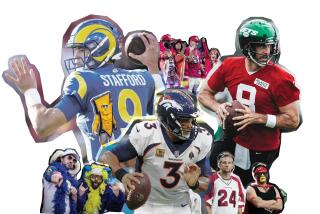Older rookie could make the team, but wouldn’t be ‘Invincible’
- Share via
“Invincible,” Walt Disney Pictures, in theaters,
The premise
VINCE PAPALE (Mark Wahlberg) is a 30-year-old teacher and part-time bartender with only one year of high school football experience, when Dick Vermeil (Greg Kinnear), the new coach of the NFL’s Philadelphia Eagles, decides to hold open tryouts. Papale, possessed of more persistence and enthusiasm than pure physical ability, tries out -- and manages to make the team, avoid major injury despite using light shoulder pads and even star in an NFL game by scoring the winning touchdown.
The questions
IS an unseasoned athlete less prone to injury because he hasn’t had to endure the constant pounding of professional football, or is he more prone because of his inexperience and lack of caution?
And is it really possible that an amateur with little experience could suddenly succeed at the highest level of professional sports -- buoyed by desire and persistence?
The reality
TO start with, though “Invincible” is based on a true story, “it is not a documentary,” says Ray Didinger, writer-member of the Pro Football Hall of Fame, senior producer for NFL Films and a former reporter who followed the real Vince Papale for the now-defunct Philadelphia Bulletin.
The real Papale “was a nationally ranked decathlon champion and had an extensive football pedigree including two years as a star in the now-defunct World Football League,” Didinger says.
Didinger thinks that Papale’s relatively “fresh” body was a big asset, however. “Papale didn’t have the cumulative damage, he didn’t have the scarring in his knees and shoulders that the other players had,” he says. Sports medicine research has found a raised risk of arthritis in the knees, hips and ankles of such players; Didinger estimates that more than 90% of professional footballers have significant knee and shoulder scarring.
Without this wear and tear to slow him, Papale was more spry and could more easily elude the kind of direct, bruising hits that might have caused injury.
Dr. Michael L. Gross, chief of Sports Medicine at the Hackensack University Medical Center in New Jersey, says that by staying in shape, an older rookie such as Papale “could conceivably avoid severe injury.”
Many published studies, he says, have shown that increasing strength, agility and coordination help protect against such injuries. A well-supervised and constructed weight training program, he adds, decreases injury rates not only in the middle-aged “weekend warrior” population, but in athletes of all ages.
Although it may seem paradoxical, Gross believes that the thin, less-protective shoulder pads also might have helped Papale because they increased his maneuverability and agility and helped him to avoid injury. (In the 1970s, when Papale was playing, all shoulder pads were light compared with today’s.)
Neither Gross nor Didinger believe a player without major talent and skill could succeed in professional football. But that’s not all it takes. Desire, says Gross, matters just as much as skill in high level sports. And Didinger believes that those who can make it in professional football have other characteristics that the rest of us lack -- such as their ability to deal with pain.
“They have to be very tough mentally to play through all the pain and injuries,” he says.
Dr. Marc Siegel is an internist and an associate professor of medicine at New York University’s School of Medicine. In The Unreal World, he explains the medical facts behind the media fiction.
More to Read
Go beyond the scoreboard
Get the latest on L.A.'s teams in the daily Sports Report newsletter.
You may occasionally receive promotional content from the Los Angeles Times.










